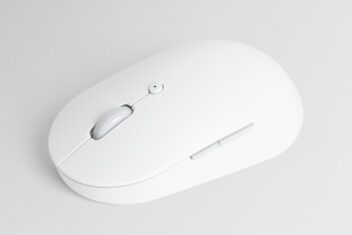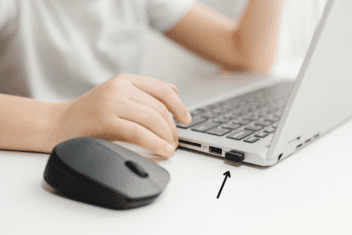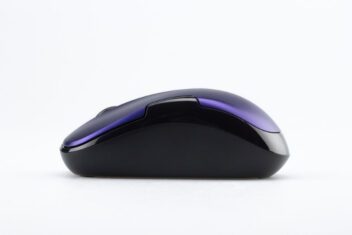Are you unsure of how to link a wireless mouse? Try not to sweat it. We’ve arrived just in time for the click. Furthermore, our helpful hints ought to work with each sort of remote mouse out there. From the simplest office computer mice to the most advanced gaming mice for your PC battle station. And this article can be helpful for (how to connect a wireless mouse to laptop). Because connecting a wireless mouse to a laptop and PC is mostly the same.

What is your mouse’s connection?
Your wireless mouse will use Bluetooth or a USB dongle to communicate with your computer.
Connecting with a USB dongle
Plug the USB dongle into any laptop or desktop port to begin using either one.
Start the wireless mouse. On its side or bottom, there ought to be a small button.
Wait for your computer to recognize the dongle. Whenever it’s recognized, you can get clicking.
Connecting via Bluetooth

Check to see if your computer supports Bluetooth. You won’t get very far without it!
No Bluetooth? Get yourself a Bluetooth connector. You can skip this step if your device already has it.
Switch on your mouse and put it into Bluetooth revelation mode. You’ll presumably need to hold down a button.
If it doesn’t pair right away, check out our suggestions down below.
You should be able to click, scroll, and move the cursor around if your mouse is properly paired.
Instructions to fix mouse connection issues
A few remote mice could have a couple of specialized hiccups sometimes. But fortunately, they are simple to fix! The following are a couple of the quickest ways of figuring them out…
Install any drivers
Take a look at the maker’s website and download the most recent drivers. Drivers are essentially a geek language that helps programming and equipment to cooperate. Introduce them, and your mouse ought to now be in total agreement with your PC.
Actually, look at the power and batteries
It could simply be that your mouse has a few old batteries in it. Or on the other hand, perhaps you neglected to put it on for a fast charge the previous evening. One way or the other, supplant the batteries (if it utilizes them) or get your charger. If one of these is the problem, you can tell pretty quickly.
Modify the settings
Navigate to the settings menu on your computer and look for the Bluetooth or mouse section. If your mouse is connected, it will be chosen as the “primary pointing device” and should be recognized (and appear in a list). In the event that it isn’t, attempt the two ideas above first before you begin plunging into any high-level investigating.

FAQ:
How do I connect my Bluetooth mouse manually?
It’s super simple. If your Bluetooth mouse doesn’t connect automatically, follow these steps:
- Start the mouse.
- Switch the mouse’s pairing mode on. Check the manual if you’re having issues.
- Go to the Bluetooth settings on your computer.
- Track down your mouse in the rundown of accessible devices.
- Click associate.
- And now you’re done. Now it should be connected to your mouse.
Where is a wireless mouse’s pairing button located?
The matching button is generally an afterthought or a lower part of the mouse. Furthermore, it will either be a switch or a tiny button. View whatever’s named with ‘associate’, ‘match’, or the Bluetooth logo. Then press it or slide it, and your mouse ought to be prepared to coordinate. Simple.
Do you want a USB collector to interface with a remote mouse?
To connect to your PC or laptop, most wireless mice use a small USB receiver. Simply plug it into any USB port and you’re all set. However, some of the more expensive ones only use Bluetooth, allowing you to connect your mouse without using USB.
How would I get my PC to perceive my remote mouse?
Assuming it has one, ensure your USB beneficiary is connected appropriately and turn on Bluetooth. Twofold checks that it has new batteries as well (except if one necessities re-energizing all things being equal). Whenever you’ve done all that, it ought to associate naturally.
Are you still having issues? Try turning off and on your computer again or restarting it. We are aware that it is the oldest known IT trick. Yet, it’s there which is as it should be. Sometimes, that’s all that’s needed to get rid of any kind of technical problem!
How to connect a wired mouse to a computer?
Most wired mice are USB-based, meaning they should plug into a USB port on your PC.
Why does my mouse keep disconnecting from Windows 11?
Check to see if the USB root hub driver changes anything. This is how it’s done:
Reinstall the USB Root Center
1) Press Windows key + X
2) Open Device Manager
3) From Device Manager, Expand Universal Serial Bus Controllers
4) For each example of a USB root hub, right-click and uninstall.
5) Reboot your PC after each uninstallation and continue to the following ones, when you have uninstalled all the root centers check the device manager again to ensure they were reinstalled back by Windows properly.
6) Check to see if the problem still exists.
Also, install any pending Windows 11 updates you find. Remember to reboot after the establishment of the update.
Tell me in a remark how it goes.
Why does my mouse keep disconnecting from Windows 10?
Assuming that you have 2 ‘Stow away grievance mice’ in the device manager (under ‘mouse and other pointing devices’), attempt to impair one of them (keep the one from your producer). Disable does the trick; uninstall is pointless because it will reinstall itself automatically.
Just an arrangement that worked for me after a long, long hunt online. Have fun!
Why does my wired mouse keep disconnecting?
Method 1: Roll-back driver
- Open the show box to squeeze Windows Key + R and type devmgmt.msc then hit enter
- Mice and other pointing devices can be found and expanded. Right-click the Stowed away consistent mouse and select Update driver
- 5. Choose Search My Computer for drivers. Select Let me pick from a rundown of accessible drivers on my PC
- Select any more seasoned driver from the rundown and snap straightaway
- After the process is finished, restart your computer to see if the problem has been resolved.
Method 2: Run System File Checker
- Launch the command prompt (as an administrator).
- Wait for the scan to finish before entering each of the commands below.
sfc /scannow
DISM /Online /Cleanup-Image /CheckHealth
DISM /Online /Cleanup-Image /ScanHealth
DISM /Online /Cleanup-Image /restore health
Quick note: If it’s not too much trouble, show restraint, it’s supposed to see the interaction stuck at 20 or 40 percent. Following a couple of moments, the interaction will finish effectively.
